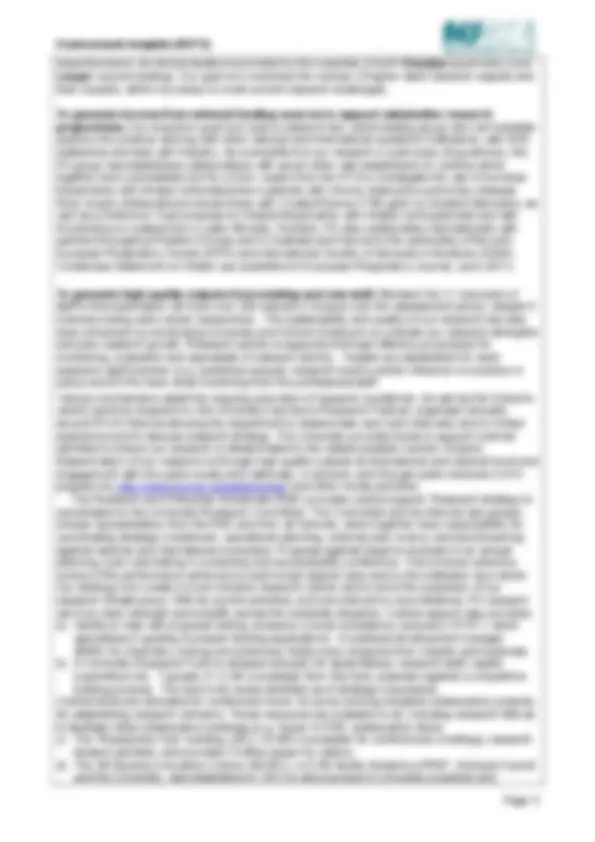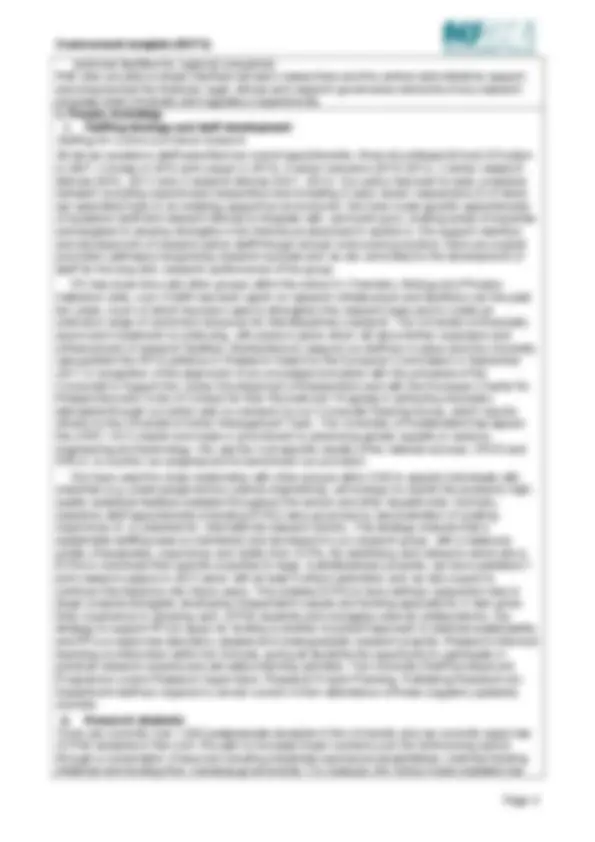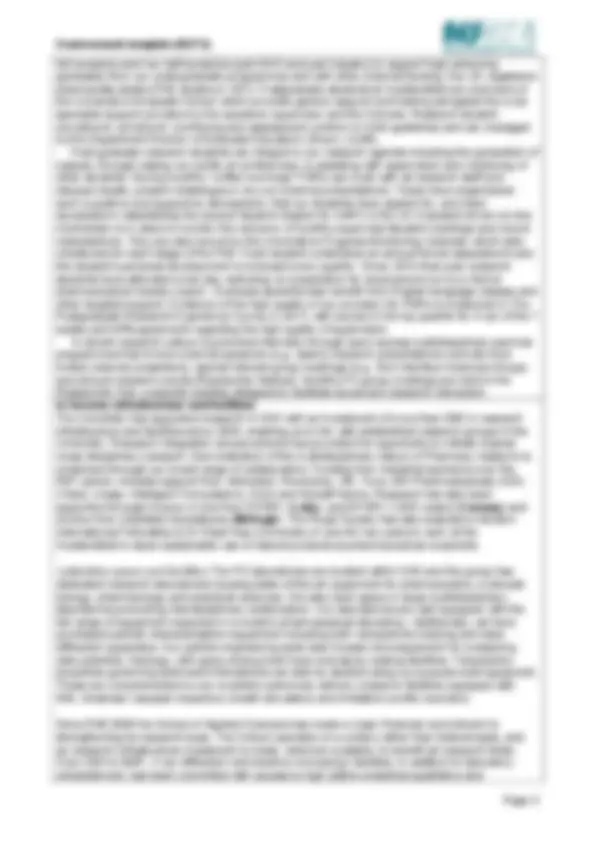





Study with the several resources on Docsity

Earn points by helping other students or get them with a premium plan


Prepare for your exams
Study with the several resources on Docsity

Earn points to download
Earn points by helping other students or get them with a premium plan
Community
Ask the community for help and clear up your study doubts
Discover the best universities in your country according to Docsity users
Free resources
Download our free guides on studying techniques, anxiety management strategies, and thesis advice from Docsity tutors
The growth and strategy of Pharmacy research at a university, focusing on the investment made in staffing, infrastructure, and postgraduate studentships to reach a critical mass. The university's commitment to becoming an internationally recognized research-led institution is demonstrated through separate submissions in REF2014 from four Departments. The research strategy emphasizes clinically and pharmaceutically relevant research, with a focus on current healthcare challenges and the creation and application of new knowledge. Interdisciplinary research is encouraged, and research themes span from molecular and cellular to individual and population levels. The university supports research excellence through funding, mentoring, and promotion pathways, and research students are integral to the research agenda.
What you will learn
Typology: Study Guides, Projects, Research
1 / 7

This page cannot be seen from the preview
Don't miss anything!




Institution: The University of Huddersfield Unit of Assessment: 3 Allied Health Professions, Dentistry, Nursing and Pharmacy a. Overview
The introduction and development of Pharmacy admirably exemplifies the implementation of the University’s wider strategy to grow research in a well-funded and thriving environment. Strategic development of a Pharmaceutical Sciences research group over the period of REF has coincided with the introduction of our MPharm undergraduate degree and graduation of the first cohort in
Our work undertakes topical, relevant and integrated research in order to expand the scientific understanding of drug properties and disease states, and define optimal strategies to help healthcare practitioners, regulators, and policy makers improve the quality and efficiency of pharmaceutical and biopharmaceutical product development. Our research is multi-disciplinary with both fundamental and applied components and key areas are supported, developed and managed through an integrated research group. Pharmaceutical Sciences Research (PS) is co- ordinated by the Pharmacy Department within the School of Applied Sciences (SAS). SAS comprises four Departments (Pharmacy and Pharmaceutical Sciences, Chemistry, Biology and Physics), each making a separate submission in REF2014, a clear demonstration of the University’s commitment to becoming an internationally recognised research-led institution. The research lead is supported by the Departmental Head, Director of Research and Dean of the School. Central University support is through The Research and Enterprise Directorate (R&E).
Pharmaceutical Sciences (Group Leader: Prof Barbara Conway)
Membership: Asare-Addo, Chrystyn, Conway, Laity, Larhrib, Leaper, McHugh, Olajide, Smith, Stephenson, Supuk.
There is a strong interdisciplinary focus, with several staff working at the interfaces between groups within SAS and other Schools. For example, the Skin Interface Sciences Group brings together research from three Schools within the University and is a key example of the success of this approach that is advancing towards a Research Institute, with support from NHS and industry. This approach has extended not only our access to research infrastructure but has also extended our translational capabilities, enabling, for example, incorporation of a medical statistician into the group ( Stephenson ).
b. Research strategy The underlying characteristic of our research is that it is clinically and pharmaceutically relevant. Effective medicinal therapy is challenging due to the route of administration, the drug and the condition and so we have built a group with the expertise to address these with close collaborations and on-going projects with clinicians within the local community, nationally and internationally. We have appointed an International Advisory Board to provide input on our long- term vision, providing strategic advice on research foci and alignment of our plans with external policies, challenges and opportunities. In order to direct research and innovation within PS, we focus on the current challenges faced in healthcare with the aim to create, disseminate, and apply new knowledge based on research in drug discovery, through material science, formulation and drug delivery, to patient use in order to enhance the quality of life through improved health. Our strength and depth in these areas fits closely with international research priorities. Our ultimate aim is to deliver real benefits for the health and wellbeing of the individual and the University's policies support initiation and management of research activity and promotion of translational aspects of our research.
The aims of the research strategy
To develop a coherent group and to expand in areas with existing expertise and provide a coherent and critical mass of quality research activity. Our strategy has been to seek a balance between the progressive recruitment of experienced researchers and the investment in
early career researchers into an enabling, supportive environment. We have adopted a research- led priority in planning and resourcing of both academic appointments and infrastructure that supports our mission “Committed to Excellence with Impact”. Our research themes bring together researchers from different disciplines spanning the range from laboratory into clinical practice within an infrastructure that supports high-quality research and the vision to promote translational research in PS. As such, we have also additional research-active staff in these areas who we fully expect to be producing high-quality, relevant research submissable to REF 2020 ( Airley, Javid, Merchant, Ousey, Patel, Waters ). We have identified strategically important research themes focusing on areas of strength and significance in Pharmaceutical Sciences.
A greater emphasis on interdisciplinary research allows us to build on existing strengths and to exploit opportunities impacting the final dosage form of medicines and management of health. We integrate research at many levels: molecular and cellular, tissue and organ, system and whole- organism, individual and population. A theme in this area runs from identification of biomarkers and disease targets ( Olajide, McHugh and Airley ), to formulation for specific users (e.g. particle engineering approach for more effective delivery of drugs via pulmonary route, Chrystyn, Larhrib, Supuk ) to effective use of medicines in hospital community groups (e.g. Leaper , Patel, Ousey ) To achieve our goals we have attracted, developed and nurtured the careers of research-focussed academics and developed support strategies for staff at all career stages. We have initiated a scheme to align early‐career academics with senior staff mentors to develop a research agenda with a high degree of ambition. Staff are also embedded into much larger structures and groupings across the University (e.g. Skin Interface Sciences Group and Carbohydrate Research Group) to help facilitate multi-disciplinary activity.
Developing high-profile, interdisciplinary research. Our strategy is to exploit our interdisciplinary collaborations, national and international relationships to extend the impact and significance of our research in the health of an individual. Our research collaborations have resulted in outputs between pharmacy, clinicians and healthcare providers nationally and internationally and will provide a base to help our practitioners develop high-quality, relevant outputs. The Royal Society has awarded one of the world’s most promising academics (Dr Elijah Nep from University of Jos, Nigeria) a fellowship (Newton International Fellowship to Nep/ Smith ) to continue and extend collaborative work with researchers at Huddersfield on releasing the pharmaceutical value of sustainable natural resources in the developing world. All PS research staff benefit from access to a wide-range of facilities and expertise, whilst retaining their independence as individual researchers. Our plans to strengthen translational research across the core disciplines of Pharmacy have been supported by appointments at Professorial level ( Chrystyn, Conway, Leaper ). Academics and research fellows have been brought together under a unifying group specifically designed to advance research, exploit complementary areas and build partnerships, e.g. particle engineering for inhalation therapies ( Chrystyn, Laity, Larhrib, Supuk) within SAS but also across schools, e.g. wound management ( Conway, Leaper , Ousey (School of Human and Health Sciences) and Fleming (School of Engineering), for the improvement of treatment of chronic conditions. We maintain a strong basic science element within the group, exemplified by the strong steer towards pharmaceutics and translation into products and guidance. In these key areas, the team approach enables a clear pathway for our research from the pharmaceutics / biopharmaceutics of the material sciences, testing and formulation design ( Conway ) through to in-vitro and in-vivo evaluations. The bridge between evaluation and
technical facilities for regional companies. R&E also provides a single interface between researchers and the central administrative support, and ensures that the financial, legal, ethical and research governance elements of any research proposal meet University and regulatory requirements. c. People, including: i. Staffing strategy and staff development
All eleven academic staff submitted are recent appointments– three at professorial level (Chrystyn in 2007, Conway in 2010 and Leaper in 2013), 4 senior lecturers (2010-2012), 2 senior research fellows (2010, 2011) and 2 research fellows (2011, 2012). Our policy has been to seek a balance between recruiting experienced researchers and investing in early career researchers (5 of whom are submitted here) in an enabling supportive environment. We have made specific appointments of academic staff and research fellows to integrate with, and build upon, existing areas of expertise and targeted to develop strengths in the themes as described in section b. We support retention and development of research-active staff through annual review and promotion; there are explicit promotion pathways recognizing research success and we are committed to the development of staff for the long term research performance of the group.
Staffing for current and future research
PS has close links with other groups within the school in Chemistry, Biology and Physics. Institution-wide, over £100M has been spent on research infrastructure and facilities over the past ten years, much of which has been used to strengthen the research base and to create an extensive range of combined resources for interdisciplinary research. The University is financially sound and investment is continuing, with plans in place which will allow further expansion and enhancement of research facilities. Mechanisms to support our staff are in place and the University was granted the HR Excellence in Research Award by the European Commission in September 2011 in recognition of the alignment of our processes and plans with the principles of the Concordat to Support the Career Development of Researchers and with the European Charter for Researchers and Code of Conduct for their Recruitment. Progress in achieving exemplary standards through our action plan is overseen by our Concordat Steering Group, which reports directly to the University’s Senior Management Team. The University of Huddersfield has signed the UKRC CEO charter and made a commitment to advancing gender equality in science, engineering and technology. We use the UoA-specific results of the national surveys, CROS and PIRLS, to monitor our progress and to benchmark our provision.
We have used the close relationship with other groups within SAS to appoint individuals with expertise (e.g. pharmacogenomics, particle engineering, cell biology) to exploit the access to high- quality analytical facilities available throughout the school and other departments. Similarly, academic staff appointments (including ECRs) were governed by demonstration of existing experience of, or potential for, international research activity. This strategy ensures that a sustainable staffing base is maintained and developed in our research group, with a balanced profile of leadership, experience and vitality from ECRs. By identifying work-streams which allow ECRs to contribute their specific expertise to large, multidisciplinary projects, we have published 7 joint research papers in 2013 alone with at least 8 others submitted, and we fully expect to continue this trajectory into future years. This enables ECRs to have defined, supported roles in larger projects alongside developing independent outputs and funding applications. It also gives them experience in directing work of PhD students and managing external collaborations. Our strategy to support RFs to apply for funding is another important approach to address sustainability and RFs co-supervise laboratory classes and undergraduate research projects. Research-informed teaching is entrenched within the Schools, giving all students the opportunity to participate in practical research projects and simulated learning activities. The University Staff Development Programme covers Research Supervision, Research Project Planning, Publishing Research etc. Department staff are required to remain current in their attendance of these (regularly updated) courses.
ii. Research students There are currently over 1,000 postgraduate students in the University and we currently supervise 22 PhD students in this UoA. We plan to increase those numbers over the forthcoming period through a combination of sources including industrially-sponsored studentships, matched funding initiatives and funding from overseas governments. For example, the School made available two
full bursaries and two half-bursaries (part-NHS and part-industry) to support high-achieving graduates from our undergraduate programmes and with other external funding, five UK-registered pharmacists started PhD studies in 2013. Postgraduate students at Huddersfield are members of the University’s Graduate School which provides generic support and training alongside the more specialist support provided by the academic supervisor and the Schools. Research student recruitment, enrolment, monitoring and assessment conform to QAA guidelines and are managed by the Department Director of Graduate Education ( Brown , UoA8). Post-graduate research students are integral to our research agenda including the generation of outputs, through raising our profile at conferences, to assisting with supervision and mentoring of other students. During monthly “coffee mornings” PGRs can meet with all research staff and discuss results, present challenges or dry-run external presentations. These have engendered such a positive and supportive atmosphere, that our students have applied for, and been successful in establishing the second student chapter for AAPS in the UK.A student-driven on-line mechanism is in place to monitor the outcome of monthly supervisor/student meetings and record notes/actions. They are also bound by the University’s Progress Monitoring Calendar which sets milestones for each stage of the PhD. Each student undertakes an annual formal assessment and the student’s personal development is reviewed every quarter. Since 2010 final-year research students have attended a two-day workshop on preparation for employment run by a former pharmaceutical industry expert. Overseas students also benefit from English language classes and other targeted support. Evidence of the high quality of our provision for PGRs is evidenced in The Postgraduate Research Experience Survey in 2013, with scores in the top quartile for 5 out of the 7 scales and 99% agreement regarding the high quality of supervision. A vibrant research culture is promoted internally through open-access multidisciplinary seminar programmes that involve external speakers (e.g. weekly research presentations normally from invited external presenters), special interest group meetings (e.g. Skin Interface Sciences Group) and annual research events (Researcher festival). Monthly PS group meetings are held in the Researcher Hub, a specific building designed to facilitate social and research interaction. d. Income, infrastructure and facilities The University has supported research in SAS with an investment of more than £9M in research infrastructure and facilities since 2008, enabling us to link with established research groups in the University. Research integration across schools has provided the opportunity to initiate original cross disciplinary research. Demonstration of the multidisciplinary nature of Pharmacy research is evidenced through our broad range of collaborators. Funding from industrial sponsors over the REF period, includes support from Admedsol, Revolymer, 3M, Teva, GW Pharmaceuticals, GSK, Chiesi, Lhasa, Intelligent Formulations, Orion and MundiPharma. Research has also been supported through income in kind from EPSRC ( Laity ), and EPSRC CASE award ( Conway ) and income from charitable foundations ( McHugh ). The Royal Society has also awarded a Newton International Fellowship to Dr Elijah Nep (University of Jos) for two years to work at the Huddersfield to study sustainable use of natural products as pharmaceutical excipients.
Laboratory space and facilities:
Since RAE2008 the School of Applied Sciences has made a major financial commitment to strengthening its research base. The School operates on a unitary rather than federal basis, and so research infrastructure investment is made, wherever possible, to benefit all research fields. Over £5M to NMR, X-ray diffraction and electron microscopy facilities, in addition to laboratory refurbishment, has been committed with access to high calibre analytical qualitative and
The PS laboratories are located within SAS and the group has dedicated research laboratories housing state-of-the-art equipment for pharmaceutics, molecular biology, pharmacology and analytical sciences. We also have space in large multidisciplinary laboratories promoting interdisciplinary collaboration. Our laboratories are well equipped with the full range of equipment expected in a modern pharmaceutical laboratory. Additionally, we have purchased particle characterisation equipment including both nanoparticle tracking and laser diffraction apparatus. Our particle engineering suite also houses new equipment for measuring zeta potential, rheology, with spray-drying (inert loop) and spray coating facilities. Triboelectric properties governing solid-solid interactions can also be studied using our purpose-built equipment. These are complemented by our excellent pulmonary delivery research facilities equipped with NGI, Andersen cascade impactors, breath simulators and inhalation profile recorders.
Esteem indicators: We are committed to taking forward a broad, interconnected programme of applied research. Staff are encouraged and supported to apply for external awards and attend and present at conferences. For example, in 2011 Waters won the British Science Association Darwin Award for public engagement, while Airley was the Royal Pharmaceutical Society Scientist of the Year in the same year. We are also committed to translating our research into government policy, or national/international practice development (detailed in Impact template and exemplified by Leaper, an Expert Member of the Advisory Committee on Antimicrobial Resistance and Healthcare- Associated Infection, Chair of focus group on MSSA screening and Chair of focus group on HII compliance ). Leaper is also
Staff regularly receive requests from international journals and funding bodies to review papers and grant applications. All staff are encouraged and supported to serve on editorial boards (e.g. Conway serves on the editorial board of the Journal of Microencapsulation, Journal of Pharmaceutics, Advances in Pharmaceutics, Asian Pacific Journal of Tropical Biomedicine) and Chrystyn is the Executive Editor of the British Journal of Clinical Pharmacology. Our active and close mentoring enables ECRs to also take on such roles, e.g. IJBMSP ( Asare-Addo ), Journal of Pharmacogenomics and Pharmacoproteomics ( McHugh ), Drug Delivery Letters, J Biomaterial App ( Smith ), British Journal of Pharmaceutical Research ( Larhrib ) and contribute to editorials as independent researchers (e.g. Nokhodchi and Larhrib (2013) ‘Overcoming the undesirable properties of dry-powder inhalers with novel engineered mannitol particles’
Emeritus Professor of Surgery at University of Newcastle upon Tyne, Imperial College, London and Consultant Advisor for Industry (Ethicon US, Smith and Nephew, Convatec, Coloplast and Martindale Pharma/Altrazeal). The establishment of the SIS Research Group has further strengthened industry links and has recruited Leaper as clinical lead. Since its inception, we have attracted local, national and international support with 9 invited editorials, 5 keynote addresses at International Conferences, an invited lecture series for Australian Wounds West Consortium and circa £40K income from industrial collaborations and awards.
Therapeutic Delivery
In addition to the University’s annual research days, staff are involved in conference organisation, e.g. Wounds UK, annually ( Ousey ), Hydrocolloids 2012 ( Smith ), UKPharmSci ( Waters ). Staff regularly review for a wide spectrum of funding sources (e.g. MRC, NC3Rs, TWAM, Orthopaedic Research UK, European Commission FP7 New indigo Partnership) and for over 70 journals across all pharmacy, healthcare and related disciplines including: AAPS PharmSciTech, Acta Biomaterialia, Alzhemier's and Dementia, Biomacromolecules, Carbohydrate Polymers, Chemistry Today, Colloids and Surfaces B, Current Medical Research and Opinion, Drug Development and Industrial Pharmacy, European Journal of Pharmaceutics, European Journal of Pharmacology, Expert Opinion in Biology, Expert Opinion on Drug Discovery, International Journal of Pharmaceutics, Journal of Biomaterials Applications, Journal of Controlled Release, Journal of Drug Delivery Science and Technology, Journal of Drug Targeting, J. Mater. Sci.-Mater, Journal of Microencapsulation, Journal of Pharmaceutical and Biomedical Analysis, Journal of Pharmaceutical Sciences, Journal of Pharmacy and Pharmacology, Langmuir, Materials, Molecular Pharmaceutics, Pharmaceutical Development and Technology, Pharmaceutical Research, Polymer, Recent Patents in Drug Delivery and Formulation, Science of Advanced Materials.
879-882 and McHugh (2011) ‘The tetrahydrobiopterin pathway: a novel target for the treatment of depression’. Pharmacogenomics, 121, 625. Attendance at conferences is strongly supported with central funds where required. (e.g. Chrystyn : Chairperson of (a) sessions at European Respiratory Society annual meetings 2009, 2010 and 2011 and (b) Health Professionals Day at ISAM 2011. Plenary presentations at RDD Europe 2009, Nordic Lung conference 2010, European Respiratory Society 2010, ISAM 2011 – 3 presentations, IPCRG 2012 and ARNS 2012). Staff have also contributed widely to books and book chapters over the period: e.g. Conway , Solids In: Integrated Foundations of Pharmacy, Oxford University Press; Ionic Solutions and Electrolytic Equilibria In: Remington: The Science and Practice of Pharmacy, 22nd edition-Pharmaceutical Press, Biopharmaceuticals – transforming disease management In: The New Optimists: Scientists View Tomorrow's World & What it Means to Us, Linus Publishing ; Drug delivery strategies for the treatment of Helicobacter pylori infections Frontiers in Medicinal Chemistry_._ We are continuing to engender this activity by supporting other staff to contribute to books relevant to current challenges in Pharmaceutical Sciences, e.g. Asare-Addo and Conway , Poorly Soluble Drugs: Dissolution and Drug Release (Pan Stanford Press-expected Jan 2014).